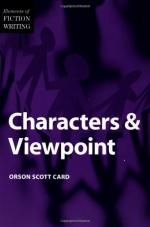
|
| Name: _________________________ | Period: ___________________ |
This test consists of 15 multiple choice questions and 5 short answer questions.
Multiple Choice Questions
1. What kind of characterization is needed in a narrative that features the characters as the primary focus?
(a) Detailed, but simple.
(b) Detailed and complex.
(c) Less detailed and simple.
(d) Less detailed, but complex.
2. Why does a character in a novel pursue a transformation in his/her life?
(a) His/her role has become insignificant.
(b) His/her role has become unbearable.
(c) His/her role has become unpredictable.
(d) His/her role has become complicated.
3. How many basic types of characters are there?
(a) Four.
(b) Two.
(c) One.
(d) Three.
4. What is part of the reader's experience of the milieu?
(a) The normalcy and predictability of the characters.
(b) The normalcy and unpredictability of the characters.
(c) The strangeness and unfamiliarity of the characters.
(d) The strangeness and familiarity of the characters.
5. What can other characters provide for the main character?
(a) Conflict, but never assistance.
(b) Conflict or assistance.
(c) Assistance, but never conflict.
(d) Neither conflict nor assistance.
6. Besides emotional, what type of attention from the reader is the goal of Chapter 7?
(a) Inadvertent.
(b) Intellectual.
(c) Subconscious.
(d) Analytical.
7. What must a writer define in creative writing?
(a) Style and tone, but not point of view.
(b) Tone and point of view, but not style.
(c) Style and point of view, but not tone.
(d) Style, tone, and point of view.
8. What is likely to cause an audience to connect with a character emotionally?
(a) Unexplained characteristics and/or thoughts.
(b) Appealing characteristics and/or values.
(c) Unexplained characteristics and/or values.
(d) Appealing characteristics and/or thoughts.
9. According to the author, what is the purpose of fiction?
(a) To give a detailed analysis of human nature.
(b) To give a better understanding of human nature.
(c) To give a detailed analysis of human mistakes.
(d) To give a better understanding of human mistakes.
10. How will the story itself suggest characters?
(a) According to the ending of a story.
(b) According to the beginning of a story.
(c) According to what needs to happen, but not how it needs to take place.
(d) According to what needs to happen and how it needs to take place.
11. What type of reputation can a character have?
(a) A character should not have a reputation.
(b) One that is not deserved.
(c) One that is deserved.
(d) Deserved or not deserved.
12. When an idea is the primary focus, what is the role of the characters?
(a) Simple plot functionaries.
(b) They define the plot in some way.
(c) They define the plot completely.
(d) Complex plot functionaries.
13. Which of the following is not an example of a broad stroke definition?
(a) Old/young.
(b) Big/small.
(c) Antagonistic/responsive.
(d) Male/female.
14. What should the writer's own experiences have in order to be used as fictional inspiration?
(a) Emotional, theoretical, or experiential connection with a character.
(b) Emotional, theoretical, or spiritual connection with a character.
(c) Emotional, spiritual, or experiential connection with a character.
(d) Theoretical, spiritual, or experiential connection with a character.
15. What must accompany self-sacrifice in an engaging character?
(a) Mystery.
(b) Reason.
(c) Sympathy.
(d) Desperation.
Short Answer Questions
1. What type of imperfections can be appealing to readers?
2. How does the author describe writing based on an issue?
3. What do the two questions the author poses at the end of Chapter 2 add to a novel?
4. Which one of the following is not an example of how to vary the names of characters to distinguish them for the reader?
5. With what does the author intend to help writers?
|
This section contains 603 words (approx. 3 pages at 300 words per page) |

|




